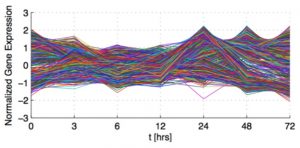Molecular mechanisms of iron homeostasis
Funding: National Science Foundation MCB Award #1120937
The ability to respond to fluctuations in nutritional availability is critical for all living cells. Multicellular organisms can respond to such challenges by altering a number of physiological, developmental, and molecular processes that are often controlled at the level of transcription. While conventional molecular biology and physiological approaches have revealed the importance of genes involved in nutrient uptake and transport, few transcriptional regulators have been identified that coordinate organismal responses to nutrient availability. Our research efforts focus on the following questions: What transcription factors regulate response to iron deprivation in plants? How do these transcription factors interact with each other and other proteins to regulate gene expression? Is there a protein complex that acts as an iron sensing mechanism in plant roots? Since plant iron transporters have the capacity to move other metals nonspecifically, studying these mechanisms will further inform us about homeostasis of other metals. Moreover, the protein-protein interactions that we examine could shed new light on iron sensing and response mechanisms conserved across diverse species.
Systems biology of nutrient stress response
Funding: National Science Foundation INSPIRE Award #1247427
Experimental datasets, such as transcriptional profiles, are often analyzed by state of the art computational tools to identify critical yet uncharacterized transcription factors. However, experimental datasets are constrained by limitations in experimental perturbation and finite experimental resources. Limited datasets may explain why traditional analysis tools have revealed few novel key regulating proteins, specifically in the iron deficiency response in Arabidopsis thaliana. Computer-based simulations from dynamic models of gene regulatory networks are being used in combination with clustering approaches to explore the perturbation space beyond what is possible by traditional experimental means, leading to the identification of hidden regulatory relationships between transcription factors and their genetic targets.
Nutrient homeostasis: Plant Signaling and Disease Response
Funding: NCSU/VT CALS Dean’s Enrichment Collaborative Grant
The capacity to sense and respond to changes in the environment is fundamental for all living organisms. Large-scale studies have revealed that responses to nutrient availability are correlated with sweeping transcriptional changes. However, little is known about the signaling processes that induce these changes or how these transcriptional changes affect plant/pathogen interactions. Our lab is using molecular biology and mathematical modeling to understand how signaling and transcriptional responses induced by nutrient stress function within molecular networks and how nutritional deficiency affects pathogenicity.
Modelling Cellular Differentiation in Plants
Funding: National Science Foundation Bilateral BBSRC NSF/ Bio Award #1517058
Plant growth and development are flexible and prone to changes in character depending on the immediate environment of the plant. The processes of growth and development in plants depend on stem cells that divide and differentiate, but little is known about the mechanisms that govern stem cell differentiation. Understanding the properties that govern stem cell differentiation into different cell types (termed the cell fate decision process) is important for understanding the transition from single stem cells into mature cells and ultimately tissues and plants. This project engages research teams from the US (North Carolina State University) and the UK (University of Cambridge) to address the complex signals and regulatory programs that orchestrate cell fate decisions. Iron is an essential plant micronutrient which when deficient affects plant developmental processes, and this project will develop mathematical models to predict the emergent behaviors that are seen in response to changing iron availability. This project will provide insights into biological mechanisms common to all organisms and has important implications for agriculture and food security in terms of increased crop yield in response to stress. The combined use of experimental and mathematical modeling approaches will provide new interdisciplinary educational opportunities in biomathematics and molecular biology, engaging students (including groups underrepresented in science) at levels from kindergarten through high school and including undergraduate and graduate students.



